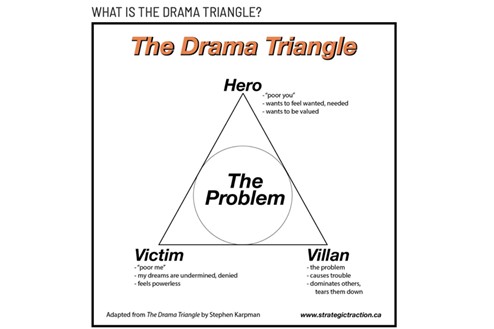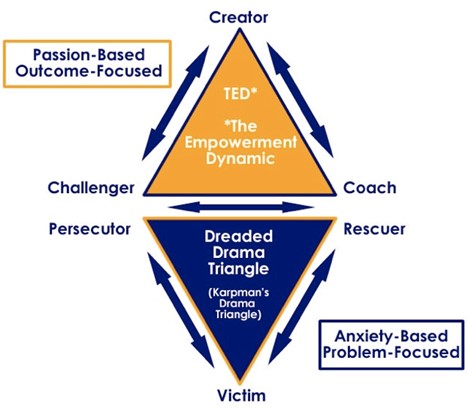Death by “Triangulation”: Transforming Toxic Dental Office Culture into Empowerment

Ahhhh, the eternal feud between dental hygienists and dental assistants. We all know the stereotypes, the plot, and how it goes. One example goes like this:
- The assistants get mad at the hygienists for leaving their dirty instruments in the sterilization room for the assistants to deal with
- Upset dental assistants go to the OM to complain that they shouldn’t have to pick up after the “primadonna hygienists”
- OM goes to the hygienists to plead the assistants’ case
- OM goes back to the assistants to plead the hygienists’ case that they’re too busy to do their instruments
… and around and around we go! And every go around it gets uglier with more animosity. Every dental office has gone through some sort of internal struggle like this if not this one in particular.
Toxic triangulation in a dental office is a brutal killer of culture and a fertile breeding ground for dwindling trust among team members. It can tear your office apart with an unfortunate side effect of attrition of valuable team members. You will be spending an exorbitant amount of time onboarding and training new hires which will translate into lost revenue. I aim to convince you that it is worth taking the time and effort to massage any situation to a healthier dynamic. If we can flip the toxic drama triangle into an “empowerment dynamic”, the office as a whole will flourish!
Objectives:
- define triangulation
- shine a light on what the healthy antithesis to triangulation looks like
- steps you can take to move toward that healthier dynamic
TRIANGULATION
What exactly is triangulation? If you go online to search the definition, you will find conflicting information across varying fields of study. You will see information about its relationship to mathematics, family dynamics, good and bad triangulation, as well as how manipulation and narcissism tend to run alongside triangulation, etc. In our office, triangulation has traditionally traveled in close proximity with gossiping and negativity. For the sake of keeping it simple, I will be referencing the definitions in the following diagram*.

- The Villain: The person who is doing the perceived harmful action to another individual
- The Victim: The party that feels that they have been treated unfairly and that they have no control over the situation
- The Hero: The person who comes to the rescue of the victim and plays the intermediary between the two parties attempting to resolve it for them. What the hero may not realize is that they are robbing the other two parties involved of the opportunity to learn and grow into more effectively communicating with each other. The Hero is demonstrating that they do not believe that the other parties involved are capable of handling the situation on their own and that they need the Hero’s help. They are, in essence, enablers.
Some examples of triangulating that you may be familiar with:
- “He always says he’ll get things done but never does.”
- “Just another example of what goes on around here all the time.”
- “I’m always having to clean up all of her mistakes!”
- “She never listens to anything I say.”
I believe it’s fair to say that this dynamic is common among dental offices. Have any of you never had knowledge of this behavior happening in their office? If so, look me up so we can chat!
Reflections:
- Of all of these roles, do you recognize any of these dynamics in your dental office?
- What role(s) have you found yourself playing in the past?
- Do you have a “typical”/ favorite role you find yourself falling into?
CHANGING THE NARRATIVE: THE EMPOWERMENT DYNAMIC *
The Villain –> The Challenger
The Challenger encourages others to learn and grow while leaving their dignity intact. They maintain their calm, kind, and curious mindset as they engage with the Victim/ Creator as to why they believe the way they do. They help to forge a new future by pressing situations that need improvement.
The Victim –> The Creator
The Creator sets boundaries and takes responsibility. They search for solutions to their predicaments rather than simply bringing complaints. They are “the author” and they make up their mind to create their future and what they want to have happen. They make the choice not to be “stuck” in any situation. They are where they have chosen to be.
The Hero –> The Coach
Rather than giving answers, the coach does not accept the responsibility for solving others’ problems. The Coach gives the problem back to them. They empower others to resolve their own difficulties by asking them questions such as “what have you tried so far?” This role of the receiver of information can have the biggest impact on stopping triangulation. They can simply choose not to accept it. If the Hero keeps attempting to fix others’ problems, others will continue to bring their problems to them!
TAKING ACTION
A healthy framework for how to effectively communicate with others is possible! As one of my favorite patients says, “We are all works in progress”!
How do we create an environment that supports everyone’s evolution into their higher counterparts in the Empowerment Dynamic? Clarity and expectations are great places to start! This can be accomplished with the development of a policy surrounding triangulation/ negativity/ gossiping. What should you consider including in your policy?
- Spell out exactly what behavior you are referencing:
- Negative talk, criticism, fault-finding about others (usually behind their back) to make them look bad
- Give reasons why it should be avoided (negative outcomes for the practice)
- What they can do if someone is choosing to triangulate/ gossip/ be negative about others:
- Remind them that speaking negatively about someone/ triangulation is not what we do here and is not the culture we want.
- Encourage them to work it out directly with the person they are gossiping about.
- Tell them if they are having trouble working it out with direct communication to request a meeting with the Coach (OM) to problem-solve together to come up with some other actions to try.
- As a last resort, the Coach can facilitate/ mediate a meeting with all parties present.
- What will the consequences be for violating the policy? A warning? Being sent home without pay? Possible termination?
Attempting to “fix” triangulation is multifaceted. Training the team on the new paradigm will require a lot of research, reflection, practice, and patience. If you are seeking supplementary guidance, I suggest you tap into some resources who are clear leaders in their field of communication and culture. Our office has utilized two coaches that we found through AADOM.
You may also want to reinforce your new policy and consulting services with a training video for the whole office and subsequent new hires to watch.
In summary, every team member needs to hold each other accountable. Dig your heels in and hold firm. For the sake of making our second “home” one where we can all thrive, feel safe, supported, and happy, you will never regret the time or funds you’ve invested when you’re on the other side looking back.
Sources:
*Triangulation Image 1 – https://www.strategictraction.ca/diffusing-drama-triangle-leaders-examine-change-role-work-relationships/
*Triangulation Image 2 – https://en.wikipedia.org/wiki/File:Drama-Triangle-The-Empowerment-Dynamic.jpg
About the Author

Melissa Smith, BS, RDH, FAADOM
Melissa is an office manager at her husband’s dental office in Prairie Village, KS. She graduated from UMKC with a degree in dental hygiene and practiced for 15 years, also serving in various roles in the Greater Kansas City Dental Hygienist’s Association, including as the organization’s president. She has been an AADOM member since 2018 and earned her Fellowship in 2021. Currently, Melissa serves as the president of the AADOM Kansas City Chapter.








